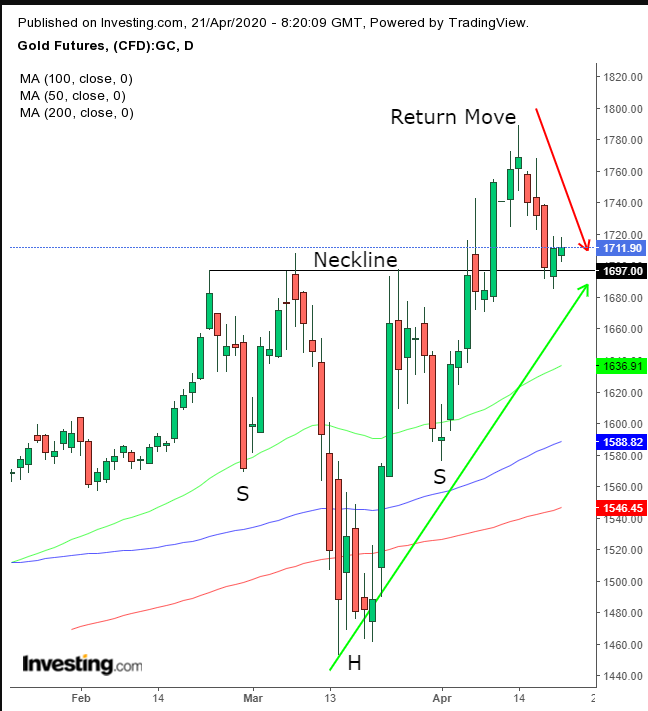- Worst quarterly earnings since 2008 expected
- Oil contract disparity sends markets reeling
Key Events
Global equities and U.S. futures for the S&P 500, NASDAQ, Russell 2000 and Dow Jones are all in the red this morning, as reports continue to circulate about the possibility that the health of North Korea’s leader may be in jeopardy. Those accounts, although as yet unverified, have injected additional uncertainty into already shaky markets roiled by the continuing spread of COVID-19 and a historic oil price meltdown yesterday.
In addition, the first big week of Q1 2020 earnings season is underway and the expectation is for the worst corporate results to be released since 2008.
The U.S. dollar strengthened and gold fluctuated.
Global Financial Affairs
On Tuesday, investors were unnerved by reports that North Korea’s Kim Jong Un was in critical condition after surgery, causing him to miss holiday celebrations. The same traders who transformed a fresh bear market into a new bull in record time suddenly turned pessimistic this morning, on worries of leadership prospects for the rogue Asian nation, and by extension global stability.
Contracts on all four major U.S. indices gave up early gains this morning and slipped into negative territory.

Futures for the S&P 500 fell for the second day, dropping below the uptrend line since the March 24 bottom. The price also dipped back below the 50 DMA, after that fell below the 200 DMA, triggering a Death Cross. The RSI and MACD are signaling a potential reversal of the underlying index.
Energy producers dragged the Stoxx Europe 600 Index lower, for the first time in four days, even after it opened higher.
In Asia, South Korea’s KOSPI, Japan’s Nikkei 225, Hong Kong’s Hang Seng and China’s Shanghai Composite fell more than 1% on the rumors out of Pyongyang; in Australia the ASX 200 dropped more than 2% after Reserve Bank of Australia chief Philip Lowe said the country's economy may contract the most since the 1930s. He believes GDP and unemployment will each fall around 10%.
Yesterday on Wall Street, all four major U.S. indices—the S&P 500, Dow, NASDAQ and Russell 2000, were each pulled lower by oil and gas stocks, which in turn were reacting to the unprecedented plunge in crude prices.
Yields, including for the benchmark 10-year note, fell to the lowest level since April 3, as demand for Treasurys increased on risk-off sentiment, boosting the U.S. dollar to its highest since April 6.

Technically, the USD extended the penetration of a completed symmetrical triangle, signaling a resumption of its previous rally.
The New Zealand dollar plummeted 1.1%.

The significant decline for the Kiwi occurred after Reserve Bank of New Zealand Governor Adrian Orr signaled willingness to directly monetize sovereign debt, as the RBNZ may end up owning 27% of the country's sovereign bonds as a result of foreign investments having been in a downward spiral since 2008. The USD/NZD pair is setting up for an upside breakout of a falling wedge, which would signal a resumption of the underlying uptrend.

Gold futures edged higher despite a stronger dollar, reinforcing the bullish view for the precious metal after the neckline of a beautifully symmetrical H&S bottom was confirmed yesterday when the price jumped back after dipping below it.
Oil sent markets reeling yesterday, with an unprecedented spread between the May and June contracts, on rising storage costs amid historically cheap pricing.

WTI was the story of the day yesterday as expiring May contracts pushed prices into negative territory for the first time ever. With storage space running out and May contracts expiring today, traders had to either roll over their very cheap contracts to much higher priced June contracts, or take delivery of the commodity—both unpalatable choices.
As a result, supply overcame demand with sellers frantically lowering prices to exit out of their trades, until at one point May futures in New York fell as low as an astonishing -$40.32.
June WTI contracts priced back above $20, the critical red line between supply and demand. The unprecedented spread between the two monthly contracts suggests that delivery of the underlying asset may become physically unfeasible.
Up Ahead
- Streaming entertainment giant Netflix (NASDAQ:NFLX) reports Q1 2020 earnings after the close today while chipmaker Intel (NASDAQ:INTC) releases results on Thursday, also after the close.
- The U.S reports Exiting Home Sales for March on Tuesday, seen to continue to decline to 5.30M from 5.77M.
- On Wednesday, the market will skip a beat when data on Crude Oil Inventories is released. It's expected to plunge to 11.676M from 19.24M.
- Another closely watched release will be Thurday's Initial Jobless Claims in the U.S., after 22 million American workers have lost their jobs, 10% of the workforce and counting.
- Friday's Core Durable Goods Orders print will likely show they've tumbled to -6.0% from -0.6%.
Market Moves
Stocks
- The Stoxx Europe 600 Index dropped 1.1%.
- Futures on the S&P 500 slipped 0.1%.
Currencies
- The Dollar Index gained 0.2%.
- The euro declined 0.3% to $1.0837.
- The Japanese yen advanced 0.2% to 107.43 per dollar.
Bonds
- The yield on 10-year U.S. Treasuries was little changed at 0.61%.
- Germany’s 10-year yield rose 2 basis points to -0.47%.
